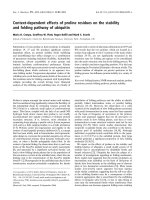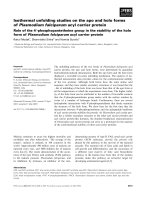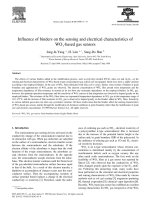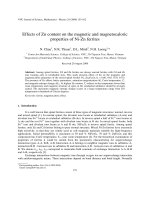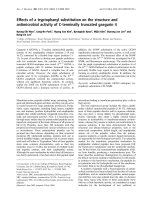Investigations on the cellular and neuroprotective functions of nogo AReticulon 4a
Bạn đang xem bản rút gọn của tài liệu. Xem và tải ngay bản đầy đủ của tài liệu tại đây (3.94 MB, 198 trang )
INVESTIGATION ON THE
CELLULAR AND NEUROPROTECTIVE FUNCTIONS
OF
NOGO-A/RETICULON 4A
TENG YU HSUAN FELICIA
(B.Sc. (Hons.)), NUS
A THESIS SUBMITTED
FOR THE DEGREE OF DOCTOR OF PHILOSOPHY
DEPARTMENT OF BIOCHEMISTRY
NATIONAL UNIVERSITY OF SINGAPORE
2010
i
Acknowledgements
My most sincere thanks goes to my supervisor, A/P Tang Bor Luen, for his
guidance, encouragement, criticisms and also financial support throughout these
years.
I like to also express my appreciation to A/P Marie-Veronique Clement and Dr
Deng Lih Wen for being my thesis advisory committee members.
Heartfelt thanks goes to the pioneers of this project, Dr Liu Haiping and Dr
Cherry Ng Ee Lin, and also my ex-labmates who have worked alongside with me in
this project, especially Ms Belinda Ling Mei Tze who has generated some of the
Nogo-A truncation constructs, and Ms Low Choon Bing and Ms Selina Aulia who
assisted in maintaining our Nogo-deficient mouse colony.
I am truly grateful to my fellow colleagues, especially Dr Ng Ee Ling and Ms
Chen Yanan for their inspiration, friendship and discussions.
I would also like to extend my thanks to my neighbouring lab’s colleagues,
especially Dr Sharon Lim, Ms Luo Le, Ms Teong Huey Fern and Dr Michelle Chang
Ker Xing, for sharing their expertise and reagents with me.
Lastly but most importantly, my deepest gratitude goes to my fantastic
husband, my adorable son and my dearest family for their endless support and
encouragement.
ii
Table of Contents
Acknowledgements i
Table of Contents ii
Summary ix
List of Publications xi
List of Figures xii
List of Abbreviations xvi
Chapter 1 Introduction 1
1.1 Discovery of Nogo-A: an inhibitor of neuronal regeneration 1
1.1.1 Neuronal regeneration is limited in adult CNS 1
1.1.2 The adult CNS environment is non-permissive to neuronal 2
growth and regeneration
1.1.3 Nogo-A present in myelin acts as a neurite outgrowth inhibitor 4
1.2 Molecular characterization of Nogo-A 6
1.2.1 Nogo: part of the Reticulon family 6
1.2.2 The Nogo gene and its splice isoforms 7
1.2.3 Subcellular localization, topology and structure of Nogo 8
1.2.4 Tissue distribution of Nogo 10
1.3 Functions of Nogo-A 13
1.3.1 Role of Nogo-A, after physical injury in adult CNS, as a myelin- 13
associated inhibitor of neuronal regeneration
1.3.1.1 Growth inhibitory domains of Nogo-A 13
1.3.1.2 Nogo-A and its neuronal receptors 14
iii
1.3.1.2.1 NgR 15
1.3.1.2.2 PirB 16
1.3.1.3 The growth-inhibitory signalling pathways elicited by 18
Nogo-A to induce neuronal regeneration inhibition
1.3.1.4 Therapeutic interventions targeting the Nogo-A-NgR 22
signalling axis
1.3.2 Role of Nogo-A in pathological conditions of CNS 25
1.3.2.1 Alzheimer’s disease (AD) 25
1.3.2.2 Amyotrophic lateral sclerosis (ALS) 26
1.3.2.3 Multiple sclerosis (MS) 28
1.3.2.4 Epilepsy 29
1.3.2.5 Schizophrenia 29
1.3.3 Nogo-A and its cell autonomous functions 30
1.3.3.1 Apoptosis 30
1.3.3.2 Organization of endoplasmic reticulum (ER) and 31
formation of nuclear envelope (NE)
1.4 Rationale of my current work 33
Chapter 2 Materials and Methods 35
2.1 General reagents 35
2.2 DNA manipulation 35
2.2.1 Design of constructs 35
2.2.1.1 Nogo-A constructs 35
2.2.1.2 Nogo-B constructs 38
2.2.1.3 Nogo-C constructs 39
iv
2.2.1.4 Reticulon 1 and 2 constructs (RTN1 and 2) 39
2.2.1.5 Reticulon 3 constructs (RTN3) 40
2.2.1.6 Caspr and Caspr 2 constructs 41
2.2.2 Molecular cloning procedure 42
2.3 Protein work 43
2.3.1 Sodium dodecyl sulphate polyacrylamide gel electrophoresis 43
(SDS-PAGE)
2.3.2 Coomassie Blue staining and destaining of SDS-PAGE gels 45
2.3.3 Western transfer and blotting 45
2.3.4 Production of GST fusion proteins 46
2.3.4.1 Preparation of GST-proteins for antigens 47
2.3.4.2 Preparation of GST-proteins for pull-down assays 48
2.3.5 Purification of antibodies 48
2.3.6 Nuclear-cytosol fractionation 49
2.4 Cell culture 50
2.4.1 Mammalian cell culture 50
2.4.2 Transient transfection 50
2.4.3 Generation of stable cell-lines 51
2.4.4 Primary culture of cortical neurons 51
2.4.5 Primary culture of oligodendrocytes and astrocytes 53
2.5 Animal work 54
2.5.1 Immunization of rabbits 54
2.5.2 Maintenance and breeding of Nogo-deficient mice 55
2.5.3 Perfusion of C57BL/6 and Nogo-deficient mice 55
2.6 Interaction studies 56
v
2.6.1 GST pull-down assays 56
2.6.2 Co-immunoprecipitation (Co-IP) 57
2.7 Localization studies 57
2.7.1 Immunocytochemistry (ICC) 57
2.7.2 Immunohistochemistry (IHC) 59
2.8 Apoptosis assessment assays 61
2.8.1 Propidium iodide (PI) labelling/ flow cytometry 61
2.8.2 Fluorimetric caspase activation assay 62
2.9 Data analysis 63
2.9.1 Confocal image analysis 63
2.9.2 Densitometric analysis 63
2.9.3 Statistical analysis 63
Chapter 3 Subcellular and tissue localization of Nogo-A 64
3.1 Generation of Nogo-A specific antibodies 64
3.2 Nogo-A is highly enriched in the CNS 67
3.3 Nogo-A is significantly expressed in both neurons and 69
oligodendrocytes but not astrocytes
3.4 Discussion – Localization of Nogo-A and the implicated functions 73
Chapter 4 Studies on the interacting proteins of Nogo-A 75
4.1 Interaction of Nogo-A with Caspr, a paranodal marker 75
4.1.1 Nogo-A co-localizes with Caspr at the paranodes 76
4.1.2 Nogo-A co-immunoprecipitates with Caspr 76
vi
4.1.3 Nogo-66, in its entirety, is essential for Nogo-A’s interaction with 78
Caspr
4.1.4 Expression of Nogo-A and Caspr during development 81
4.1.5 Nogo-A is not essential for the architecture organization at the 82
node of Ranvier
4.2 Interaction of Nogo-A with RTN3, a fellow member of the Reticulon 84
family
4.2.1 Nogo-A co-localizes with RTN3 at ER 84
4.2.2 Nogo-A co-immunoprecipitates with RTN3 85
4.2.3 The region from TM1 to TM2 of Nogo-A is necessary for its 87
interaction with RTN3
4.2.4 Both TM domains and possibly the N-terminus of RTN3 is 89
involved in its interaction with Nogo-A
4.3 Discussion – Nogo-A’s interaction with Caspr and RTN3 91
Chapter 5 Nogo-A and other isoforms are protective 93
against a variety of apoptotic insults
5.1 Generation of SH-SY5Y cell-lines stably and moderately 94
overexpressing Nogo-A, -B, -C and RTN3
5.2 All three major Nogo isoforms and RTN3 protect against serum 96
withdrawal-induced cell death
5.3 All three major Nogo isoforms and RTN3 protect against 97
staurosporine-induced cell death
5.4 Nogo-A, -B and RTN3, but not Nogo-C, protect against etoposide- 99
induced cell death
vii
5.5 Nogo-A, -B and RTN3, but not Nogo-C, enhance cell death induced by 100
tunicamycin
5.6 Only Nogo-A and -B could protect against H
2
O
2
-induced cell death 101
5.7 Discussion – Nogo-A’s role in neuroprotection 103
Chapter 6 Possible mechanisms involved in Nogo-A’s 104
protection against H
2
O
2
-induced cell death
6.1 Protection against H
2
O
2
requires N-terminus of Nogo-A/B 104
6.2 Protection by Nogo-A does not involve classical survival pathways 106
6.2.1 Intrinsic differences in classical survival markers in the stable 106
cell-lines
6.2.2 Activation of Akt and Erk upon H
2
O
2
treatment 107
6.2.3 Inhibition of Akt and Erk do not influence Nogo-A’s protective 108
ability
6.3 Involvement of the mitochondria-associated intrinsic apoptotic pathway 112
in Nogo-A’s protective effect
6.3.1 Changes in the levels of mitochondrial-death associated proteins 112
with Nogo isoforms and RTN3 expression
6.3.2 Nogo-A and -B expression reduce H
2
O
2
-induced activation of 114
caspase-3 and -9
6.4 The role of the unfolded protein response (UPR) or ER stress response in 116
Nogo-A’s protective function
6.5 Investigations on changes in nuclear factor қB (NF-B) 118
6.5.1 Intrinsic differences of NF-B p65 subunit in the stable cells 118
viii
6.5.2 NF-B p65 nuclear translocation in SH-SY5Y cells induced by 119
TNFα is affected by Nogo isoforms and RTN3 expression
6.5.3 Translocation of NF-B p65 subunit upon stimulation with H
2
O
2
121
6.6 Discussion – mechanisms involved in Nogo-A’s protection against 122
H
2
O
2
-induced cell death
Chapter 7 Discussions and Conclusions 124
7.1 Localization of Nogo-A in CNS 124
7.2 Enrichment of Nogo-A at the paranode and its interaction with Caspr 125
7.3 Interaction of Nogo-A with RTN3 127
7.4 Neuroprotection by Nogo-A and the possible mechanisms involved 129
7.5 Concluding remarks 133
Chapter 8 Bibliography 135
Appendices
Appendix 1: Primers used for DNA constructs A1
Appendix 2: Primary antibodies used in western blotting A2
ix
Summary
Nogo/RTN4 belongs to the Reticulon (RTN) family, which comprises of four
members, RTN 1-4. There are three major splice isoforms of Nogo/Rtn4, namely
Nogo-A, -B and -C. Nogo is first discovered as a myelin-associated neurite outgrowth
inhibitor localized at the oligodendrocytes where it interacts with its neuronal
receptor, NgR, to elicit its neurite growth inhibitory effect. However, the endogenous
physiological role of Nogo has remained unknown.
In our studies, we have generated specific antibodies against Nogo-A, showed
that it is enriched in the paranodal region, and that it interacts with the neuronal axon-
glial junction protein Caspr. Nogo-A’s interaction with Caspr implied a function at
the axon-glial junction, but comparative analysis did not reveal significant changes in
the structural organization of the node in Nogo-deficient mice. Nogo-A also interacts
with RTN3, another member of the RTN family. We demonstrated that this
interaction is stronger than Nogo-A’s low affinity to RTN1 and RTN2, and have
molecularly dissected the interaction domains involved in Nogo-A-RTN3 interaction.
As Nogo-A levels are elevated in neurons (but not oliodendrocytes) in brain
injuries and ischemia, we investigated if elevated Nogo-A could have a
neuroprotective effect. Moderate Nogo-A expression could protect SH-SY5Y
neuroblastoma cells against a myriad of pro-apoptotic stimuli such as H
2
O
2
, serum
deprivation, staurosporine and etoposide. Tunicamycin-induced cell death, however,
is enhanced by Nogo-A expression. The same effects are also observed by Nogo-B
expression. On the other hand, while Nogo-C and RTN3 confer some degree of
protection against serum deprivation, staurosporine and etoposide, they are not
effective against apoptosis induced by H
2
O
2
.
x
Stable Nogo-A expression does not intrinsically induce upregulation of anti-
apoptotic proteins such as Bcl-2 and Bcl-xL, but instead causes downregulation of
pro-apoptotic Bid truncation and AIF. Nogo-A expression also increases the basal
levels of total and activated Bax. This correlates with increased basal levels of
activated caspase-3. Indicators of the unfolded protein response (UPR), one type of
ER stress responses, are, however, not significantly elevated. Focusing on H
2
O
2
induction of cell death, we investigated on the possible neuroprotective mechanisms
of Nogo-A. We show that Akt and Erk are not necessary for Nogo-A’s protective
effect against H
2
O
2
. Any UPR-based preconditioning is also found not to be
accountable for Nogo-A’s protection. Interestingly, Nogo-A expression is able to
attenuate caspase-3 and -9 activation upon H
2
O
2
treatment. This implies that Nogo-A
may protect by the attenuation of the intrinsic pathway and the subsequent caspase-
dependent apoptosis. We also observe some differences in terms of nuclear
translocation of p65/RelA subunit of NF-қB between the Nogo-A expressing and
control cells, which may, at least partly, contribute to Nogo-A’s neuroprotective
function.
The work presented in this thesis provided insights into possible cell
autonomous functions of Nogo-A other than its role in neurite outgrowth inhibition.
In line with earlier observations that Nogo-A is elevated during brain injury, Nogo-A
may thus have a role as a component of the neuron’s injury response and survival
preservation mechanism.
xi
List of Publications
Teng F.Y. and Tang B.L. (2010) Rtn3 and Nogo/Rtn4 isoforms expression protects
SH-SY5Y cells against multiple death insults. (manuscript in preparation)
Teng F.Y. and Tang B.L. (2008) Cell autonomous function of Nogo and reticulons –
the emerging story at the endoplasmic reticulum. J. Cell. Physiol., 216: 303-308.
Teng F.Y. and Tang B.L. (2006) Axonal regeneration in adult CNS neurons –
signaling molecules and pathways. J. Neurochem., 96: 1501-1508.
Teng F.Y., Lim B.M.T. and Tang B.L. (2004) Inter- and intracellular interactions of
Nogo: new findings and hypothesis. J. Neurochem., 89: 801-806.
xii
List of Figures
Fig 1.1 Inhibition of axonal regeneration upon CNS injury. 5
Fig 1.2 Domain structure and topology of Nogo. 11
Fig 1.3 Neuronal regeneration inhibitory signalling pathways activated 21
by Nogo-A.
Fig 3.1 Amino acid sequence and protein size of the antigen used for the 65
production of Ng1V2 rabbit polyclonal antibodies.
Fig 3.2 Nogo-A was specifically detected by Ng1V2 antibodies. 66
Fig 3.3 Nogo-A was highly enriched in the brain and spinal cord. 68
Fig 3.4 Expression of Nogo-A during brain development. 68
Fig 3.5 Nogo-A was expressed in primary cortical neurons and 69
oligodendrocytes but not astrocytes.
Fig 3.6 Nogo-A co-localized with cortical neurons and oligodendrocytes 71
but not astrocytes in primary culture.
Fig 3.7 Nogo-A expression during cortical neuronal differentiation. 72
Fig 3.8 Nogo-A was present in the neurons, especially at the paranodes, 73
and oligodendrocytes of the spinal cord.
Fig 4.1 Nogo-A co-localized with Caspr at the paranodes. 77
xiii
Fig 4.2 Nogo-A co-IP Caspr. 78
Fig 4.3 Antigenic regions for Caspr and Caspr 2 antibodies. 79
Fig 4.4 The entire Nogo-66 was required to pull-down Caspr. 80
Fig 4.5 Expression of Caspr during brain development. 82
Fig 4.6 Nogo-A did not affect the architecture organization at the node of 83
Ranvier.
Fig 4.7 Nogo-A co-localized with RTN3 at the ER. 85
Fig 4.8 Nogo-A co-IP RTN3 to a better extent than with RTN1 and 2. 86
Fig 4.9 The region from TM1 to TM2 of Nogo-A was necessary for its 88
interaction with RTN3.
Fig 4.10 Both TM domains were essential for RTN3’s interaction with 90
Nogo-A.
Fig 5.1 Stable protein expression profiles in SH-SY5Y stable cell-lines. 95
Fig 5.2 All Nogo isoforms and RTN3 protected SH-SY5Y against serum 97
withdrawal-induced cell death.
Fig 5.3 All Nogo isoforms and RTN3 protected SH-SY5Y against 98
staurosporine-induced cell death.
Fig 5.4 Nogo-A, -B and RTN3 protected SH-SY5Y against etoposide- 99
induced cell death, but not Nogo-C.
xiv
Fig 5.5 Nogo-A, -B and RTN3 enhanced SH-SY5Y cell death by 101
tunicamycin while Nogo-C had no effect.
Fig 5.6 Nogo-A and -B specifically protected SH-SY5Y against H
2
O
2
- 102
induced cell death.
Fig 6.1 The N terminus of Nogo-B was involved in protection against 105
H
2
O
2
-induced cell death.
Fig 6.2 Total and phosphorylated protein levels of Akt, Erk and GSK3α/β 106
were unaltered by RTNs’ expression.
Fig 6.3 Akt and Erk activation upon H
2
O
2
treatment. 108
Fig 6.4 Inhibition of Akt did not enhance cell death in Nogo-A stable cells. 110
Fig 6.5 Inhibition of Erk did not enhance cell death in Nogo-A stable cells. 111
Fig 6.6 Expression levels of Bcl-2 family proteins and AIF in SH-SY5Y 114
stable cell-lines.
Fig 6.7 Intrinsic caspase-3 activation in SH-SY5Y stable cell-lines. 115
Fig 6.8 Activation of caspase-3 and -9 in SH-SY5Y stable cell-lines upon 116
H
2
O
2
treatment.
Fig 6.9 Activation of UPR in SH-SY5Y stable cell-lines. 117
Fig 6.10 Expression levels of NF-B p65 subunit in SH-SY5Y stable 119
cell-lines.
Fig 6.11 TNFα-induced NF-B p65 subunit translocation in stable cell-lines 120
did not lead to cell death.
xv
Fig 6.12 NF-B p65 subunit translocation in stable cell-lines upon H
2
O
2
121
treatment.
Fig 7.1 Possible mechanisms induced by Nogo-A and -B leading to 134
survival.
xvi
List of Abbreviations
aa amino acid
AD Alzheimer’s disease
AIF apoptosis inducing factor
AFC 7–amino–4–trifluoromethylcoumarin
ALS Amyotrophic lateral sclerosis
APP amyloid precursor protein
ATCC American Type Culture Collection
ATP adenosine triphosphate
Aβ β-amyloid
BACE1 β-site amyloid precursor protein cleaving enzyme 1
Bcl-2 B-cell lymphoma protein-2
bp base pair
BSA bovine serum albumin
cDNA complementary DNA
CDS coding sequence
c-FLIP cellular FLICE-like inhibitory protein
CHO Chinese hamster ovary
CNPase 2’, 3’-cyclic nucleotide 3’-phosphodiesterase
CNS central nervous system
CO
2
carbon dioxide
co-IP co-immunoprecipitation
CREB cAMP response element-binding protein
CRELD1 cysteine rich with EGF like domains 1
xvii
CSF cerebrospinal fluid
CSPGs chondroitin sulphate proteoglycans
CST corticospinal tract
DG dentate gyrus
DIV days in vitro
DMEM/F12 Dulbecco’s Modified Eagle Medium: Nutrient Mixture F-12
DNA deoxyribonucleic acid
dNTPs (A, T, G ,C) deoxyribonucleotide triphosphates (adenine, thymine, guanine,
cytosine)
DP1 deleted in polyposis
DR5 death receptor 5
DRG dorsal root ganglion
Drs downregulated by v-src
DTT dithiothreitol
E7 embryonic day 7
E.coli Escherichia coli
EAE experimental autoimmune encephalomyelitis
EDTA ethylenediaminetetraacetic acid
EGFR epidermal growth factor receptor
EOR ER overload response
ER endoplasmic reticulum
EST expressed sequence tag
FADD Fas-associated death domain protein
FBS fetal bovine serum
FITC fluorescein isothiocyanate
xviii
GFAP glial fibrillary acidic protein
GPCR G protein-coupled receptor
GPI glycosylphosphatidylinositol
GRP94 glucose regulated protein 94
GST glutathione S-transferase
H
2
O
2
Hydrogen peroxide
HA hemagglutinin
HEK Human embryonic kidney
HRP horse radish peroxidase
Hsp heat shock protein
IACUC Institutional Animal Care and Use Committee
ICC immunocytochemistry
Ig immunoglobulin
IHC immunohistochemistry
IP
3
inositol 1,4,5-triphosphate
IPTG isopropyl-β-D-thiogalactopyranoside
JNK Janus N-terminal kinase
kDa kilodaltons
LB Luria-Bertani Broth
LGI1 LRR protein leucine-rich glioma inactivated
LILRB2 leukocyte immunoglobulin (Ig)-like receptor B2
LINGO-1 LRR and Ig domain-containing, Nogo Receptor-interacting
Protein
LRR leucine-rich-repeat
MAG myelin-associated glycoprotein
xix
MANI Myelin-Associated Neurite-outgrowth Inhibitor
MBP myelin basic protein
MEM minimum essential medium
MGC Mammalian Gene Collection
mRNA messenger RNA
MS Multiple sclerosis
NE nuclear envelope
NF 155 155-kDa isoform of neurofascin
NF-kB nuclear factor қB
NIH National Institutes of Health
NSCs neural stem cells
NSP neuroendocrine-specific protein
NUS National University of Singapore
O.C.T. Optimum Cutting Temperature
OMgp oligodendrocyte myelin glycoprotein
P1-2 postnatal day 1-2
PARP Poly (ADP-ribose) polymerase
PBS phosphate buffered saline
PCR polymerase chain reaction
PDI protein dismutase isomerase
PERK protein kinase R-like ER kinase
PF paraformaldehyde
PI propidium iodide
PI3K phosphoinositol-3-kinase
PKC protein kinase C
xx
PLL poly-L-lysine
PMSF phenylmethylsulphonyl fluoride
PNS peripheral nervous system
PTEN phosphatase-and-tensin homolog
RE restriction enzyme
RFU relative fluorescence units
RHD reticulon homology domain
Rho-GDI Rho GDP dissociation inhibitor
ROCK Rho-associated protein kinase
ROS reactive oxygen species
RNA ribonucleic acid
RPMI Roswell Park Memorial Institute
RTN reticulon
SALMs synaptic adhesion-like molecules
sd standard deviation
SDS sodium dodecyl sulphate
SDS-PAGE sodium dodecyl sulphate polyacrylamide gel electrophoresis
siRNA small interfering ribonucleic acid
SOD Cu-Zn superoxide dismutase
SPF specific pathogen free
TACE TNFα converting enzyme
tBid truncated Bid
TEMED N, N, N, N-Tetramethy-Ethylenediamine
TM transmembrane
TNF tumour necrosis factor
xxi
TRAIL TNF-related apoptosis-inducing ligand
Tx-100 Triton X-100
TxR Texas Red
UPR unfolded protein response
V volt
1
Chapter 1 Introduction
1.1 Discovery of Nogo-A: an inhibitor of neuronal regeneration
1.1.1 Neuronal regeneration is limited in adult CNS
Adult mammalian central nervous system (CNS) has been notoriously known
by its inefficiency to regenerate and self-repair. This inability is especially crucial in
situations where the CNS is „damaged', like in physical injuries such as spinal cord
injuries and brain trauma, or in non-physical ones such as neurodegenerative diseases.
As axons are usually severed or degenerated in these instances, recovery of function is
therefore greatly dependent on the ability of the axons to regenerate. Patients who
suffer from physical severing of axons may have to endure with paralysis for the rest
of their lives, while those who suffer from neurodegenerative disorders will gradually
lose either or both of their sensory and motor functions, and eventually premature
death. Exceptions may only be observed in specific pathways, such as those in the
hippocampus (Chauvet et. al., 1998) and olfactory bulb (Monti et. al., 1980; Morrison
and Costanzo, 1995). In contrast, the adult peripheral nervous system (PNS), the other
nervous system in the body, is more than capable of regeneration. When a PNS
neuron is severed, its axon is able to regenerate, and in many cases, able to
reinnervate target tissues.
There are two possibilities for the differing regenerative capacities of the two
nervous systems. One reason could be that CNS neurons are intrinsically incapable of
regeneration as compared to PNS ones. However, this notion appears not to be
entirely true. Ramón y Cajal, commonly regarded as „the father of neuroscience‟ and
the one who coined the term „neuronal plasticity‟, observed that CNS neurons were
not intrinsically unable to regenerate but exhibited only limited regeneration (Ramón,
2
1928). Another report showed that the CNS branch of dorsal root ganglion (DRG)
axons had better growth capacity after preconditioning lesions were carried out, which
also suggests that CNS neurons are intrinsically capable of regenerating (Neumann
and Woolf, 1999).
A second plausible reason for the lack of regeneration in the CNS is that the
environment in CNS is growth-inhibitory and not growth-promoting. It became
evident that the tissue environment indeed played a crucial role during regeneration,
with studies showing injured CNS neurons, although unable to regenerate when in a
CNS environment, being able to do so in the presence of a peripheral nerve
environment when PNS grafts were inserted into different regions of the CNS (Dam-
Hieu et. al., 2002; David and Aguayo, 1981; Richardson et. al., 1980; Schwab and
Thoenen, 1985). Schwab and Thoenen (1985) observed that newborn rat sympathetic
or sensory neurons, when placed in the middle of a three-compartment chamber with
sciatic and optic nerve explants on either side, were able to grow out of the former but
not the latter. This observation convincingly demonstrated the non-permissive
substrate conditions that pervade the CNS. This was performed in the presence of
optimal amounts of nerve growth factor, which suggested that a lack of trophic factors
in CNS was at least not the major reason for the lack of regeneration in CNS.
1.1.2 The adult CNS environment is non-permissive to neuronal growth and
regeneration
It has been suggested that after CNS injury, glial scars which serve to contain
the wound site and confine inflammation and cellular degeneration (Faulkner et. al.,
2004), also inevitably act as a mechanical barrier that prevents axonal growth and
reconnection (Ramón, 1928; Reier et. al., 1983; Silver and Miller, 2004). Neurite
3
outgrowth was inhibited in studies using in vitro glial scar models, thus confirming
that the presence of glial scars formed during CNS injury does play a role in limiting
axonal regeneration (Rudge and Silver, 1990; Wanner et. al., 2008). When injury is
inflicted in the CNS, proliferation and activation of astrocytes (astrogliosis) in the
vicinity of the injury site occur, together with the recruitment of other cell types such
as the microglia, oligodendrocyte precursors and meningeal cells to the injury site.
This eventually resulted in the formation of a glial scar (Fig 1.1).
The reactive astrocytes present at the glial scar become hypertrophic and
secrete extracellular matrix molecules collectively known as chondroitin sulphate
proteoglycans (CSPGs) (including molecules such as aggrecan, brevican, versican and
NG2). These CSPGs are known to be inhibitory to neuronal regeneration (McKeon et.
al., 1991; Asher et. al., 2001). Removal of CSPGs by treatment with glycan trimming
chondroitinase ABC resulted in improved regeneration (Bradbury et. al., 2002; Moon
et. al., 2001; Yick et. al., 2000). This indicated that these molecules play an important
role in contributing to the growth-inhibitory environment in CNS.
Another contributor to the non-permissive growth conditions in CNS is the
oligodendrocytes themselves (Schwab and Caroni, 1988). Oligodendrocytes are
responsible for myelination of axons in CNS, analogous to the myelination of PNS
axons by Schwann cells. Upon CNS injury, debris that originated from the myelin
structures ensheathing the neurons before lesion remains at the vicinity of the injury
site (Fig 1.1). This means that the severed axons are exposed to the myelin debris
present. Myelin produced by oligodendrocytes has been reported to have an inhibitory
effect on neuronal regeneration.
The first important hint that myelin could play a major role in the inhibition of
neuronal regeneration was from the studies performed by Schwab and Thoenen


